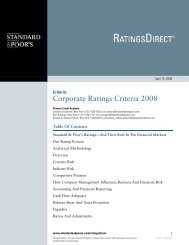European Infrastructure Finance Yearbook - Investing In Bonds ...
European Infrastructure Finance Yearbook - Investing In Bonds ...
European Infrastructure Finance Yearbook - Investing In Bonds ...
You also want an ePaper? Increase the reach of your titles
YUMPU automatically turns print PDFs into web optimized ePapers that Google loves.
Transactional Structure<br />
Standard & Poor’s performs detailed assessment<br />
of the project’s structural features to determine<br />
how they support the project’s ability to perform<br />
and pay obligations as expected. Key items<br />
include assessing if the project is structured to be<br />
a single-purpose entity (SPE), how cash flow is<br />
managed, and how the insolvency of entities<br />
connected to the project (sponsors, affiliates<br />
thereof, suppliers, etc.), who are unrated or are<br />
rated lowly, could affect project cash flow.<br />
Special-purpose entities (SPEs)<br />
Projects generally repay debt with a specific<br />
revenue stream from a single asset, and since for<br />
projects we rate to debt maturity, we need to have<br />
confidence that the project will not take on other<br />
activities or obligations that are not defined when<br />
the rating is assigned. When projects are duly<br />
structured as and remain SPEs, we can have more<br />
confidence in project performance throughout the<br />
debt tenor. If such limitations are absent, we<br />
would tend to rate a project more like a<br />
corporation, which would typically assume higher<br />
credit risk. Standard & Poor’s defines a projectfinance<br />
SPE as a limited-purpose operating entity<br />
whose business purposes are confined to:<br />
• Owning the project assets;<br />
• Entering into the project documents (e.g.,<br />
construction, operating, supply, input and<br />
output contracts, etc.);<br />
• Entering into the financing documents (e.g.,<br />
the bonds; indenture; deeds of mortgage;<br />
and security, guarantee, intercreditor,<br />
common terms, depositary, and collateral<br />
agreements, etc.); and<br />
• Operating the defined project business.<br />
The thrust of this single-purpose restriction is<br />
that the rating on the debt obligations represents,<br />
in part, an assessment of the creditworthiness of<br />
specific business activities and reduces potential<br />
external influences on the project.<br />
One requirement of a project-finance SPE is<br />
that it is restricted from issuing any subsequent<br />
debt that is rated lower than its existing debt. The<br />
exceptions are where the potential new debt was<br />
factored into the initial rating, debt is<br />
subordinated in payment, and security to the<br />
existing debt does not constitute a claim on the<br />
project. A second requirement is that the project<br />
should not be permitted to merge or consolidate<br />
STANDARD & POOR’S EUROPEAN INFRASTRUCTURE FINANCE YEARBOOK<br />
PROJECT FINANCE/PUBLIC-PRIVATE PARTNERSHIPS<br />
with any entity rated lower than the rating on the<br />
project debt. A third requirement is that the<br />
project (as well as the issuer, if different)<br />
continues in existence for as long as the rated<br />
debt remains outstanding. The final requirement<br />
is that the SPE have an anti-filing mechanism in<br />
place to hinder an insolvent parent from bringing<br />
the project into bankruptcy. <strong>In</strong> the U.S., this can<br />
be achieved by the independent-director<br />
mechanism, whereby the SPE provides in its<br />
charter documents a specification that a voluntary<br />
bankruptcy filing by the SPE requires the<br />
consenting vote of the designated independent<br />
member of the board of directors (the board<br />
generally owing its fiduciary duty to the equity<br />
shareholder[s]). The independent director’s<br />
fiduciary duty, which is also to the lenders, would<br />
be to vote against the filing. <strong>In</strong> other jurisdictions,<br />
the same result is achieved by the “golden share”<br />
structure, in which the project issues a special<br />
class of shares to some independent entity (such<br />
as the bond trustee), whose vote is required for a<br />
voluntary filing.<br />
The anti-filing mechanism is not designed to<br />
allow an insolvent project to continue operating<br />
when it should otherwise be seeking bankruptcy<br />
protection. <strong>In</strong> certain jurisdictions, anti-filing<br />
covenants have been enforceable, in which case<br />
such a covenant (and an enforceability opinion<br />
with no bankruptcy qualification) would suffice.<br />
<strong>In</strong> the U.K. and Australia, where a first “fixed<br />
and floating” charge may be granted to the<br />
collateral trustee as security for the bonds, the<br />
collateral trustee can appoint a receiver to<br />
foreclose on and liquidate the collateral without a<br />
stay or moratorium, notwithstanding the<br />
insolvency of the project debt issuer. <strong>In</strong> such<br />
circumstances, the requirement for an<br />
independent director may be waived.<br />
The SPE criteria will apply to the project (and<br />
to the issuer if a bifurcated structure is<br />
considered), and is designed to ensure that the<br />
project remains nonrecourse in both directions: by<br />
accepting the project’s debt obligations, investors<br />
agree that they will not look to the credit of the<br />
sponsors, but only to project revenues and<br />
collateral for reimbursement; investors, on the<br />
other hand, should not be concerned about the<br />
credit quality of other entities (whose risk profile<br />
was not factored into the rating) affecting project<br />
cash flows.<br />
Where the project acts as operator, the analysis<br />
NOVEMBER 2007 ■ 101



